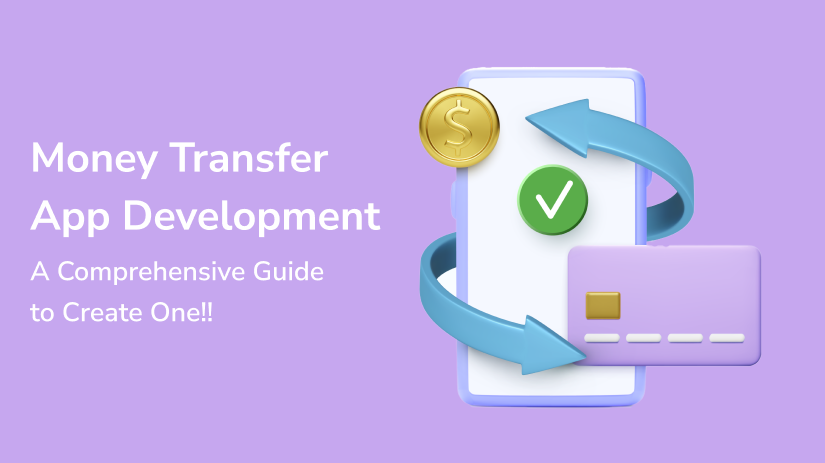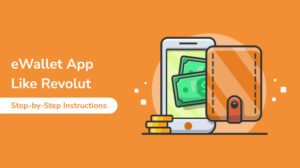In today’s digital age, money transfer apps have become an integral part of our lives, revolutionizing the way we send and receive money. With the convenience of smartphones and the internet, transferring money has never been easier.
If you’re considering entering the lucrative world of fintech by developing your own money transfer app, you’re in the right place! In this comprehensive guide, we’ll walk you through the essential steps and considerations to create a successful money transfer app.
Let’s Start!!
What is a Money Transfer App?
A Money Transfer App is a digital platform that allows users to send and receive money electronically using their smartphones or other internet-enabled devices.
These payment app developments typically link to a user’s bank account, debit card, or credit card, enabling them to transfer funds to other individuals or businesses quickly and conveniently.
Money transfer apps often offer features such as instant transfers, bill payments, international money transfers, and peer-to-peer payments. Examples of popular money transfer apps include PayPal, Venmo, Cash App, and Zelle.
Maybe you got the idea about the money transfer app’s meaning and basic function of it. Let’s see the different types of money transfer apps in the following section.
Connect with us for Fintech Development Needs
Trusted by companies like Plaid, Yodlee, Codat.
Types of Money Transfer App
Money transfer apps come in various types, each catering to different user needs and preferences. Here are some common types of money transfer apps:
1. Peer-to-Peer (P2P) Payment Apps
- These apps allow users to send and receive money directly from friends, family, or acquaintances.
- P2P payment apps are popular for splitting bills, sharing expenses, and reimbursing friends.
- Examples include Venmo, Cash App, and Zelle.
2. Mobile Wallet Apps
- Mobile wallet apps store funds digitally and enable users to make payments, transfer money, and perform other financial transactions.
- They often support additional features such as mobile recharge, bill payments, and online shopping.
- Examples include Apple Pay, Google Pay, and Samsung Pay.
3. Remittance Apps
- Remittance apps specialize in international money transfers, allowing users to send money across borders quickly and affordably.
- They typically offer competitive exchange rates and low transaction fees compared to traditional remittance services.
- Examples include TransferWise (now Wise), Remitly, and WorldRemit.
4. Bank-Owned Apps
- Many banks offer their own mobile banking apps with built-in money transfer capabilities.
- These apps allow users to transfer funds between their bank accounts, pay bills, and manage their finances conveniently.
- Examples include Chase Mobile, Bank of America Mobile Banking, and Wells Fargo Mobile.
5. Cryptocurrency Wallet Apps
- Cryptocurrency wallet apps enable users to store, send, and receive digital currencies such as Bitcoin, Ethereum, and Litecoin.
- They often feature advanced security measures such as private key management and multi-signature authentication.
- Examples include Coinbase, Blockchain Wallet, and Exodus.
6. Cross-Border Payment Apps
- Cross-border payment apps focus on facilitating international transactions for businesses and individuals.
- They may offer features such as multi-currency wallets, foreign exchange services, and compliance with international regulations.
- Examples include PayPal, Revolut, and Payoneer.
7. Business Payment Apps
- Business payment apps cater to the needs of merchants, freelancers, and small businesses, enabling them to accept payments and manage invoices.
- They may include features such as invoicing, payment tracking, and integration with accounting software.
- In this category donation software or donation-accepting apps are also considered. Nonprofit organizations can easily receive donations through online payment apps with feature-rich mobile applications for donations. The most popular example of donation software is DonorKite – The best online donation software.
- Examples include Square, Stripe, and QuickBooks Payments.
8. Social Payment Apps
- Social payment apps combine social networking features with money transfer capabilities, allowing users to send money to contacts and engage in social transactions.
- They may incorporate features such as group payments, payment requests, and social feeds.
- Examples include Facebook Messenger Payments, Snapchat Cash, and Instagram Checkout.
Now, explore the common features that every money transfer app should have!!
Key Features of Money Transfer App
User Registration
Enable users to create accounts easily using email, phone number, or social media credentials.
Secure Authentication
Implement robust security measures such as two-factor authentication (2FA) to protect user accounts from unauthorized access.
Bank Account Linking
Allow users to link their bank accounts or payment cards to facilitate seamless transactions.
Send Money
Enable users to send money to friends, family, or businesses instantly, with options for recipient selection and payment confirmation.
Receive Money
Provide multiple options for users to receive money, including bank transfers, mobile wallets, or cash pickup, with notifications upon receipt.
Transaction History
Maintain a comprehensive record of all transactions for users to track their spending, view transaction details, and monitor their financial activity.
Notifications
Send real-time notifications to users for transaction updates, account activity, and promotional offers to keep them informed and engaged.
Customer Support
Offer responsive customer support through various channels such as in-app chat, email, or phone, to address queries, resolve issues, and provide assistance when needed.
Security Features
Implement advanced security features such as encryption, biometric authentication, and device authorization to safeguard users’ data and transactions from cyber threats and fraud.
Currency Conversion
Support currency conversion for international transfers, displaying exchange rates and providing cost-effective options for currency conversion.
Bill Payments
Allow users to pay bills directly from the app, including utilities, rent, and subscriptions, simplifying their financial management process.
Split Bills
Enable users to split bills with friends or groups, facilitating easy expense sharing for dining, travel, or other shared activities.
Promotions & Rewards
Offer promotional incentives and rewards programs to encourage user engagement and loyalty, such as cashback offers, referral bonuses, or loyalty points.
Integration with Third-Party Services
Integrate with third-party services such as ride-sharing apps, e-commerce platforms, and financial management tools to enhance user convenience and functionality.
Compliance with Regulatory Requirements
Ensure compliance with regulatory standards and financial regulations, such as Know Your Customer (KYC) and Anti-Money Laundering (AML) laws, to mitigate risks and maintain trust with users and regulatory authorities.
Connect with us for Fintech Development Needs
Trusted by companies like Plaid, Yodlee, Codat.
How To Build a Money Transfer App: Step-by-Step Guide
The surge in digital payments has spurred a growing demand for secure and user-friendly money transfer apps. While developing such an app may seem daunting, with the right strategy, it’s an achievable journey.
At ProtonBits, we are committed to supporting aspiring entrepreneurs like yourself in realizing your app aspirations. With extensive experience in the fintech industry, we offer invaluable guidance throughout the process.
Establishing a Solid Foundation
This initial stage lays the groundwork for your app’s success.
Market Analysis
Our team conducts thorough market research to identify gaps in the industry that your innovative solution can address. We also assess the strengths and weaknesses of existing apps.
Precision in Target Audience
We assist you in defining your ideal users with precision, whether it’s millennials sending quick digital tips or families managing complex international remittances.
Simplified Feature Prioritization
Leveraging our fintech expertise, we help you prioritize essential features, considering functionality, cost, and time constraints to ensure maximum value delivery to your target audience.
Navigating Regulatory Challenges
Regulatory compliance is a complex landscape. We provide invaluable guidance to ensure your app complies with all relevant financial regulations, saving you time and resources.
Designing an Intuitive User Experience
A seamless user experience is crucial for user retention.
Effortless Navigation
We design intuitive and user-friendly interfaces that anyone can navigate effortlessly, regardless of their tech proficiency.
Smooth Onboarding Process
We ensure a seamless and hassle-free signup process, minimizing friction points to encourage user retention.
Transparent Communication
We help you clearly communicate fees, exchange rates, and transaction processes, fostering trust and confidence among users.
Cross-Platform Compatibility
Our expertise ensures your app functions seamlessly across various devices and platforms (iOS, Android, web), reaching users wherever they are.
Engineering Secure Money Transfer Systems
This phase focuses on building robust and secure money transfer systems.
Tech Stack Expertise
We assist you in selecting a robust and secure tech stack that aligns perfectly with your app’s features, scalability, and budget.
Tech stacks such as Ruby on Rails development framework, Node.js, Django, etc. are used in the backend development of money transfer apps.
Seamless API Integrations
We integrate your app seamlessly with financial institutions, payment gateways, and other essential services, ensuring smooth and reliable money transfers.
Prioritizing Security
User data protection is paramount. We prioritize it with industry-standard encryption, multi-factor authentication, and robust fraud detection systems.
Rigorous Testing
Our team conducts thorough testing across various scenarios and devices to guarantee your app’s functionality and security before launch.
Security Is Paramount
In the realm of fintech software development, security is paramount. Using ProtonBits, you can protect your users in the following ways:
Data Encryption
We employ industry-standard encryption techniques to safeguard private user information both in transit and at rest, ensuring total security.
Proactive Vulnerability Management
We routinely check your app for vulnerabilities and address them promptly to minimize security concerns.
Compliance with Security Requirements
We assist you in upholding pertinent security requirements, such as PCI DSS, demonstrating your commitment to user trust and data safety.
At ProtonBits, we are committed to guiding you through every step of the money transfer software development journey, ensuring your app is not only functional and secure but also successful in meeting the needs of your target audience.
Conclusion
In conclusion, developing a money transfer app requires meticulous planning, robust technology infrastructure, and a deep understanding of user needs and market dynamics.
By following this comprehensive guide and staying abreast of industry developments, you can create a successful and sustainable money transfer app that adds value to users’ lives and disrupts the financial services industry.
Happy Money Transfer App Development!!
Connect with us for Fintech Development Needs
Trusted by companies like Plaid, Yodlee, Codat.





